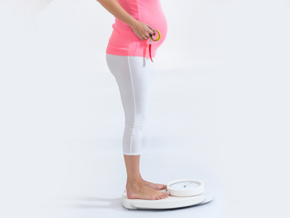
Monitoring your response to exercise
Monitoring your response to exercise
It is important to monitor your response to your exercise programme by taking your pulse-rate before, during and after exercise. Underworking will show no benefits and overworking may harm you and your baby. The correct pace will allow you to carry on a conversation while exercising (talk test).
Talk test is exactly what it says – the ability to talk during your workout – and can help you determine how hard you are working. If you can converse comfortably during exercise you are working out at an acceptable intensity and are probably in the low-to middle-range of the Perceived Rate of Exertion
Scale (PRE).
Monitoring perceived rate of exertion
The Perceived Rate of Exertion Scale (PRE) is based on a mother’s ability to rate (according to a number scale) her body’s response to exercise. Each number on the scale represents a description of the mother’s perceived rate of exercise intensity.
In a class of 10 pregnant women, the PRE scale may vary from 7–19 depending on age, fitness and stage of pregnancy.
No one knows your body better than you do – you are the best judge of how you are feeling. This form of exercise monitoring can be used in conjunction with pulse taking and the “talk test”.
| How does exercise feel? | Rating |
| Very, very light | 6 / 7 / 8 |
| Very light | 9 / 10 |
| Fairly light | 11 / 12 |
| Somewhat hard | 13 / 14 |
| Hard | 15 / 16 |
| Very hard | 17 / 18 |
| Very, very hard | 19 / 20 |
You should be working at a rate of 13–15 on the PRE scale, at a pace that you would describe as “moderately challenging”.
Resting pulse
Your resting pulse rate, which should be taken before rising in the morning, will increase slightly as your pregnancy advances, and may drop as you become fitter.
Related articles

Further comfort measures for pain relief
Distractions like breathing, visualising or fixing on one point can take your mind off the pain.
5 mins to read

Levels of fitness
First trimester
Your fitness is likely to decrease. Listen to your body and only do what you feel comfortable doing.
Second trimester
5 mins to read



Criteria for prenatal classes
Instructor’s credentials, for example, midwife, physiotherapist.
Instructor’s specialised training in childbirth education.
5 mins to read

Conception
The fertilised egg divides into two identical cells – then four, then eight, then 16, and then many billions, and 266 days later – your baby.
1 min to read

How Much Weight Should I Gain During Pregnancy?
There are many things you can do to prepare for the delivery of a healthy baby. One of the most important things is eating right to gain the extra weight you’ll need to support another life.
4 mins to read

Preconception checklist
Are you planning to have a baby soon? Find out our preconception checklist to facilitate the conceiving process and have an healthier pregnancy.
1 min to read

Maintaining and improving fitness
Stimulating the cardiovascular system through aerobic exercise helps to maintain and improve your fitness during pregnancy.
5 mins to read


Breathing techniques
Breathing reflects the activity in your body and, of all the body’s involuntary unconscious physical responses, breathing is the easiest to control.
4 mins to read


Diagnostic tests
Diagnostic ultrasound
The most important scans are performed at 12 weeks and 16 weeks. These early scans often prove the most accurate in determining the date of birth.
3 mins to read

Relaxation and correct breathing techniques
As your pregnancy advances, the uterus exerts an increased upward pressure on your diaphragm. As you near your due date you may find that you breathe less deeply, although more efficiently.
5 mins to read

Breathing and relaxation
The Pros
-
Offers immediate relief.
-
Decreases tension and offers good pain relief.
5 mins to read

Diagnosis and signs of the pregnancy
Confirm a suspected pregnancy immediately to avoid unnecessary risks to your baby.
1 min to read

Guidelines for exercise during and after pregnancy
Before exercising, during or before pregnancy, it is advisable to eat high fibre, high carbohydrate snacks, such as an apple, dried fruit, banana or whole wheat muffin, as your metabolic functions
5 mins to read

Checklist – before baby arrives
Make sure you have everything you need for your baby's arrival with our checklist. Get organized and feel confident for the big day.
5 mins to read

Health and fitness
Ideally, you should assess your health and fitness. You may need to make some changes to your lifestyle
3 mins to read